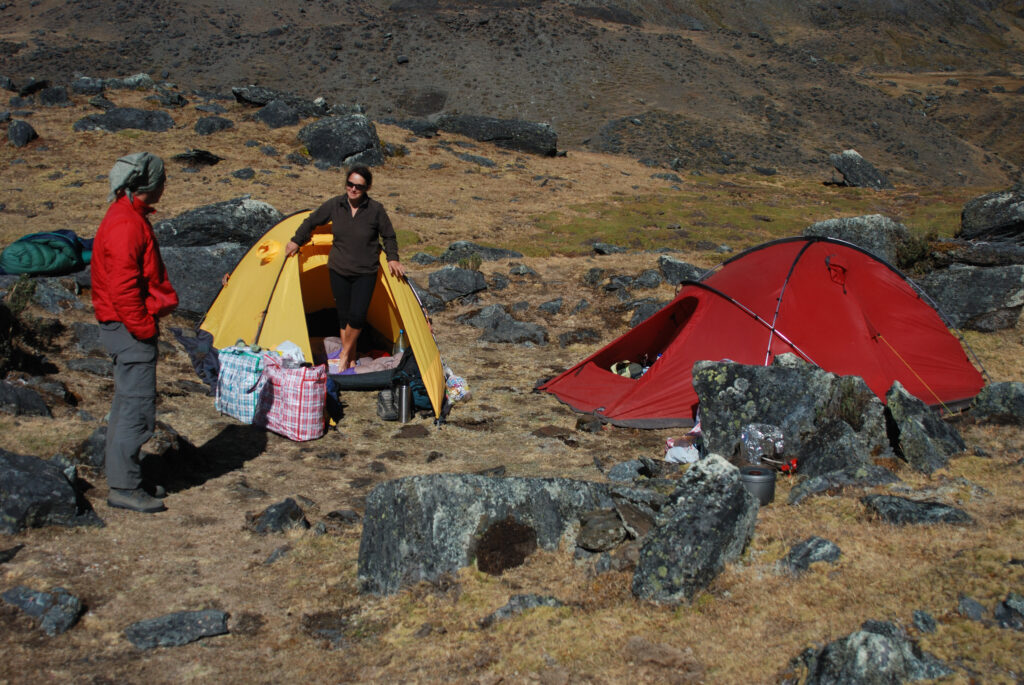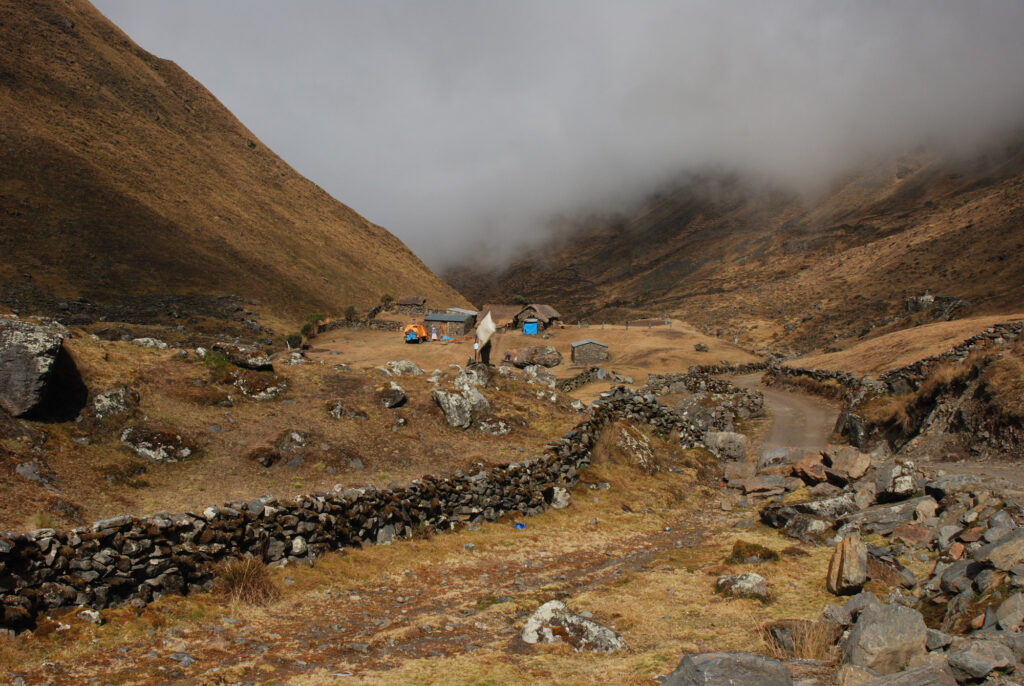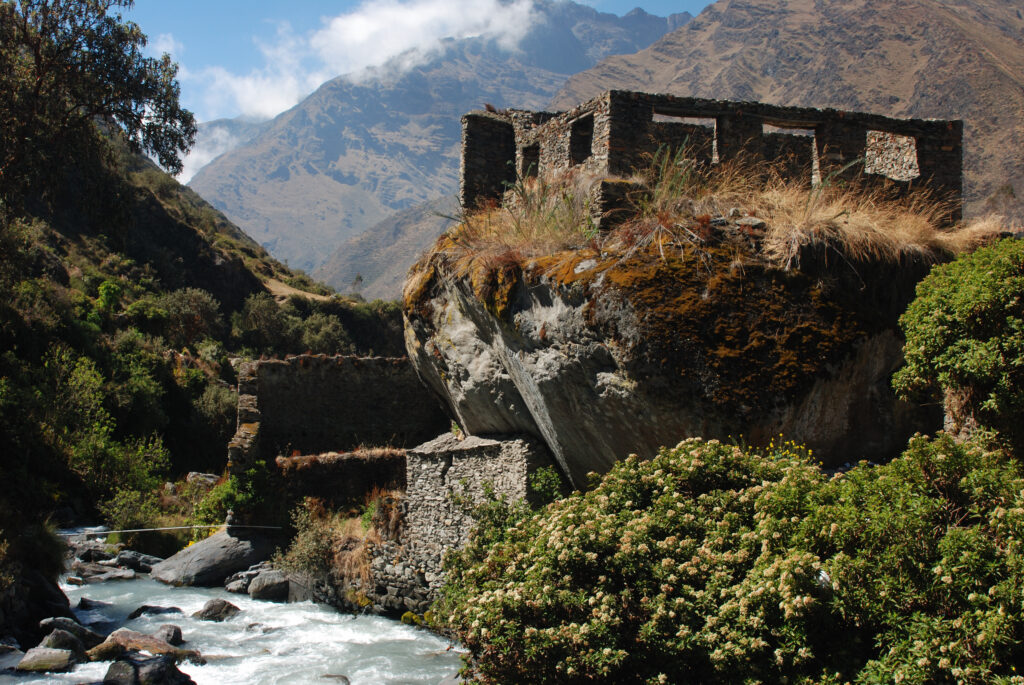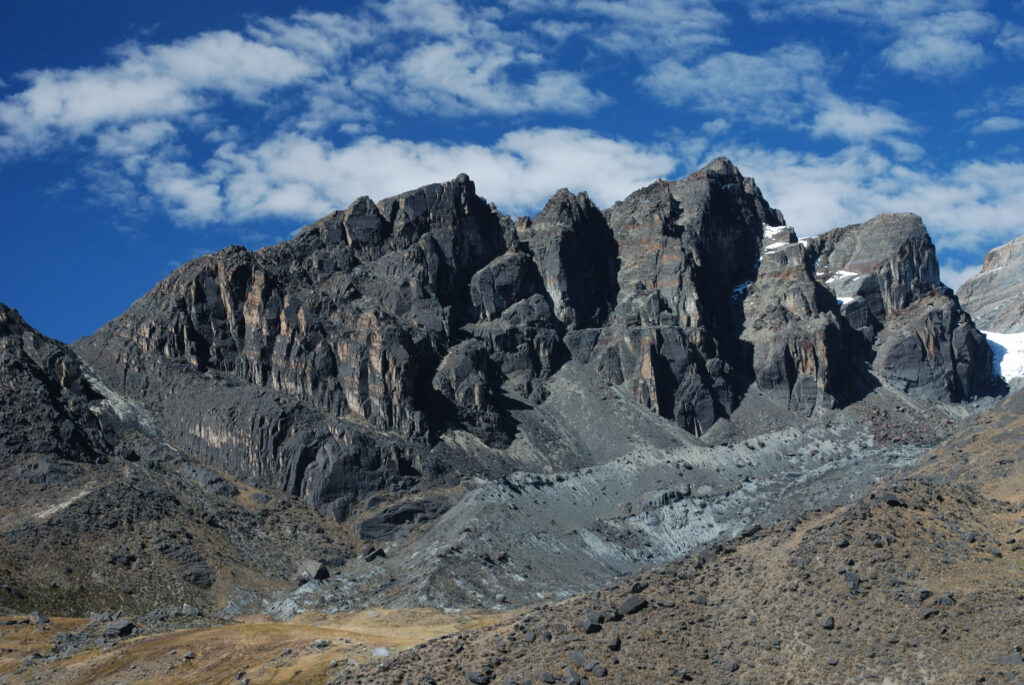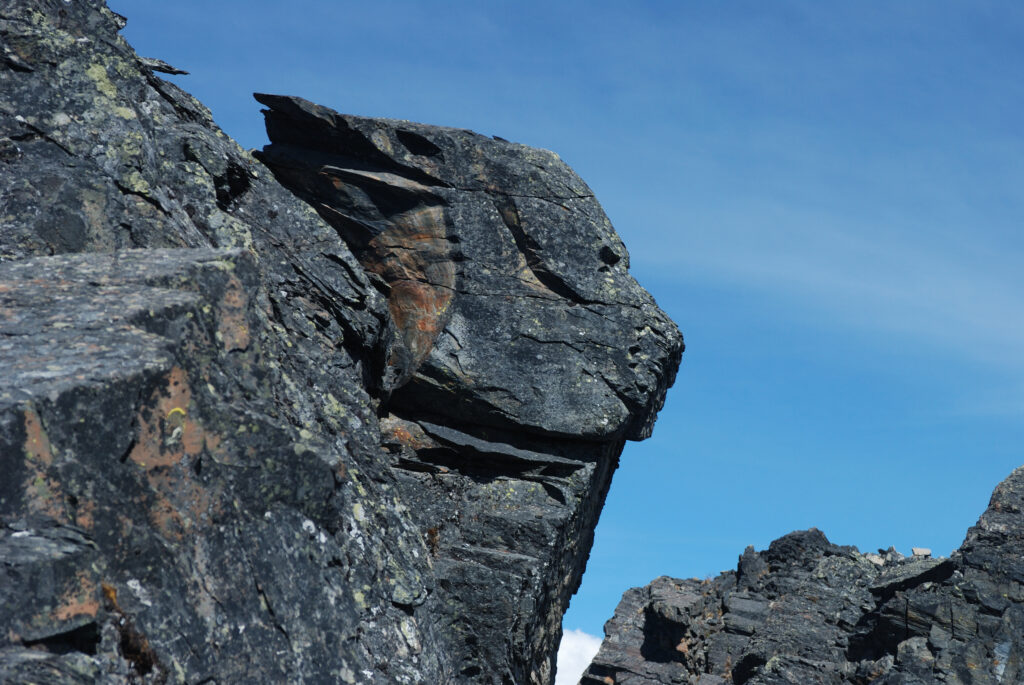The Explore Apolobamba 2009 expedition operated in the Huancasayani region for 20 days. During this time, the participants of the expedition achieved four first ascents to the summits: Trata Tata (a name given by the Polish expedition), Couquenzi West, Nevado Losoccocha, and La Indigna (also named by the Polish expedition). Additionally, they managed to reach the summit of FAE3, which had been previously climbed only once by a German expedition in 1997.
The Heart of Apolobamba - Pelechuco
Looking out of the crowded bus window at the perfectly flat, expansive plains scattered among the Andean peaks of the Ulla Ulla region, I cannot resist the impression that they were designed by a brilliant architect to capture the essence of the word “Apolobamba,” and not the other way around. “Apolobamba” (originally “Apullu Pampa”) – “several plateaus” – is one of the most remote and least-visited areas in the Bolivian Andes. It is the kingdom of vicuñas, ibises, Andean condors, flamingos, chinchillas, and Andean bears (Jucumaris). Dozens of peaks here remain untouched by human footsteps. It is their magic that has been drawing me like a magnet for several months now.
The road winds through hills, crosses plateaus, descends into deep, yellow-green valleys, only to climb up to the next pass with great effort. Chinchilla groups dart away from under the wheels of the speeding bus. Curious alpaca herds stop and look back at the roaring monster that forced them off the road. Suddenly, a screeching sound fills the air, and the bus brakes abruptly to stop at a small square in the center of the town of Pelechuco. A group of locals rushes to the luggage compartments, eager to retrieve their bags and distribute presents to the impatient children.
A trip to La Paz is not an everyday occurrence for the residents of villages scattered throughout the Apolobamba valleys. So when such a celebration happens, they bring plenty of “exclusive” gifts for their loved ones. The children wait restlessly for their parents’ return from the capital, just as if they were waiting for Santa Claus.
Almost like in cartoons, a crowd of people with arms and legs sticking out here and there finally moves away from the bus. We collect our dusty, crumpled backpacks. Daria and Wojtek volunteer to stay with the luggage while Kuba and I head straight to the only hotel in the town, Hotel Llajtaymanta. There are rooms available! A moment later, we are sitting at the table, a hot, nourishing soup steaming in front of us, and Ronaldo, the hotel owner, runs around the town to organize a caravan for us. After a few dozen minutes, he returns, accompanied by señora Rimi, the owner and driver of a small herd of mules. The bargaining begins. Communicating with Rimi is not easy. Although he speaks Spanish, his strong Aymara accent makes understanding each word quite challenging. Every other sentence needs to be repeated. After several minutes of trying to communicate in Spanish, Aymara, and even some sign language, we manage to agree on a price of 75 BOB for each mule, 75 BOB for the mule driver (arriero), and 75 BOB for an assistant for each day of the trek. It seemed like the bargaining was over, but unfortunately, it was just an illusion. We want to reach the Huancasayani valley in 3 days, but Rimi insists it will take 4 days. We want to take 4 mules, but Rimi claims we’ll need 5. The final dispute is resolved through the ritual of weighing the baggage. Rimi approaches each of our backpacks one by one, lifting them up and muttering quietly: – “Pesado” (heavy).
Unfortunately, we can’t argue with such an argument, and we are forced to agree to take 5 animals.
In accordance with South American customs, Rimi arrives only around noon. Now it’s time for the ritual of harnessing the animals. The mule driver and his assistant load the bags and backpacks onto the mules’ backs, adjusting and readjusting them several times, ensuring they are securely attached to the animals. Children gather around, clearly not used to seeing tourists, and perform for us. We give them some candies to leave them with pleasant memories of the encounter with strangers. Finally, at around 2 PM, we manage to set off.
The three-day journey to the Huancasayani valley passes by with struggles against strong acclimatization headaches and admiration for the Andean nature. Every few hours, we pass herds of alpacas grazing on the countless meadows of Apolobamba. Occasionally, a chinchilla darts out from under our feet. From time to time, we catch a glimpse of a herd of vicuñas on the horizon…
Vicuñas are the smallest camelids in the world. In Poland, vicuñas, guanacos, alpacas, and llamas are all commonly referred to as “lamas.” However, these animals are significantly different from each other. Vicuñas and guanacos are wild animals. Vicuñas are smaller, live in the mountains and highlands, have light beige wool, and are under strict protection. Guanacos can also be found only in the Andes. Several decades ago, these animals inhabited the vast South American plains in Patagonia and south of the Gran Chaco plain, but poachers seeking their highly valuable wool wiped them out from these areas. Alpacas and llamas are domesticated animals. They are bred in the Andes for their wool, skins, meat, and also used as pack animals. For the inhabitants of Apolobamba, these animals are the foundation of their existence.
In the Apolobamba National Park, the world’s largest population of vicuñas, around 2,500 individuals, thrives. Additionally, in the less-visited corners of Apolobamba, Andean bears and condors can also be found…
This rarely visited region is our destination. On the third day of the trek, we finally enter the Huancasayani valley. The valley is built in terraces, and from its successive levels, a stream cascades down, creating menacing yet stunning waterfalls. On the horizon, we recognize the first peaks. For months, we studied materials about the valley, studied maps, looked at photos, and now we see it in reality. To the right, a towering, several hundred meters high pillar of Hucuncunki impresses, in the distance, a glacier tongue on Couquenzi catches the eye, right in front of us, four “devilish” summits of Kura Huari shimmer in the sun, and slightly to the left, the valley is closed by the Lusuni pass.
Lusuni is a border pass between Bolivia and Peru. However, there is no border post or crossing here—the nearest ones are several hundred kilometers to the south. A smuggling trail passes through this pass. Due to significant price differences for animals between Bolivia and Peru, entire herds of horses, llamas, and mules are driven through here.
We finally set up our long-awaited camp. The sound of a babbling stream fills the air, it’s green all around, alpacas graze nearby, and the mountains teem with life. From here, it’s just an hour and a half walk to the Lusuni pass, provided walking above 4,500 meters can be called a walk.
Rimi and his assistant bid us farewell and descend to Pelechuco. For the next three days, Huancasayani belongs to us… and to our mules.
Apolobamba is a land of happy animals. They are not kept in pastures; they roam freely. When the owner wants to find their herd, they ask the local residents where it was last seen and start searching in that area. There are no thieves; everyone knows each other well and knows which animals belong to whom. As a result, our mules were released near our campsite and wandered towards the Peruvian border.
The first three days in the valley pass with acclimatization excursions and rest. We hike to the Lusuni pass to get a view of the Peruvian part of Apolobamba. We also climb two other unnamed passes, approach the summits of Hucuncunki, and with each passing moment, we feel better.
Finally, the time comes to challenge Apolobamba further.
As our first goal of mountaineering activity, we chose the steep, jagged rocky ridge that limits the Huancasayani valley from the south. The four monumental steel-gray peaks frighten us a bit on one side, but on the other side, they entice us.
We wake up well before dawn, boil water for porridge, drink tea, have breakfast, pack our gear, and set off. We manage to cross the valley quickly, ford the stream, and approach a small hanging gully from which we plan to attack the pass. Now, a plateau covered with tussocks lies in front of us. Everything seems to go according to plan when suddenly my legs start sinking. A bog! The more energetically I move, the deeper I sink. However, I don’t give up and continue forward. Only a few meters separate me from the slope and large boulders, so I won’t turn back now and try to go around the bog. At one point, my leg sinks knee-deep into the peat. The rest of the team decides to bypass the difficult terrain, but I have no choice; I must somehow free myself and crawl to the slope. Thank goodness everything is frozen and dry. During the day, it probably wouldn’t have been so easy to escape, but now, fortunately, I manage to free my legs. I crawl. I try to touch the ground with as much of my body surface as possible. Several minutes later, I reach the slope. My heart is pounding like crazy. Now I begin to understand the danger I was exposed to just moments ago.
After some time, the rest of the team joins me, and together we climb the ridge.
The pass is wide, and it seems to be visited for some reasons. We find the remains of a stone wall, probably built by shepherds. The long-awaited orange sun appears from behind the horizon and fills us with additional optimism. The view is fantastic! Brownish-gray walls crowned with snowy caps shine in the morning light. Overhangs on the steepest eastern ridge look even more threatening yet more dignified than yesterday. In fact, if we were to turn back from here, I think everyone would still be satisfied. However, we have the strength, weather, time, equipment, a well-coordinated team, water supplies, and snacks, so there is no reason to end this adventure now. We continue along the ridge towards the higher parts of the massif.
On the second pass of the day, Daria starts feeling unwell. She decides to descend to the base camp. Kuba wants to accompany his wife, but in such situations, the woman has the final say, so Kuba reluctantly continues the climb in our company.
Finally, we encounter the first technical, or perhaps more psychological difficulties. The massive rock block that we have been using is cracked. We have to jump over a several-centimeter-wide rock gap. Concentrating for a moment, we make it to the other side. Without any more adventures, we reach the first, lowest summit on the ridge, and there… a surprise! We find a small flag, which clearly indicates that we are not the first to reach this summit.
We know only of two climbing expeditions that operated in this area, and none of them mentioned reaching this summit in their report. In 1997, the German expedition Forchheimer Anden-expedition conquered most of the main peaks of the Andes in this area. The American-New Zealand expedition, from which we received valuable materials about Huancasayani, also reached several summits, but everything was thoroughly described in their report and presented in photographs. Our summit was not there. This can only mean that at least one more group operated in this area, about which we have not yet found any information.
We don’t give up and continue moving forward. After a while, we come across a wide crevice that is impossible to jump over. Fortunately, it’s not very deep, so we decide to descend to the bottom and climb the opposite wall. We take out the rope from our backpack and set up a rappel. Thankfully, it’s not too difficult, and we manage to reach the bottom of the crevice smoothly. Now, the challenge is to get back up…
The wall seems quite manageable. We can see some ledges where we can potentially rest, and securing ourselves shouldn’t be a problem either.
I put on the harness, tie the rope, strap on the backpack, slip on the climbing shoes, and start climbing. Right from the beginning, something feels off. The start of the route is not trivial; it requires a bold and steady approach. As my climbing instructor always says, “As the beginning, so the entire route.”
I start climbing. I ascend a few meters, intending to set up a protection point. Unfortunately, the rock I picked for this purpose breaks in my hand. I nervously search for an alternative spot for protection. My knees start trembling from nervousness. I’m afraid the fragile foothold might slip from under me. I stand firmly, but in this type of rock, anything can happen. I find a small crack at hip height and place the protection there. I know that if I fall from the rock, I will probably pull it out, but somehow, it gives me a bit more confidence. I reach for a handhold on the rock. The grip is weak, and the rock is slightly slippery. I fumble with my hands, trying to find something better to hold onto. Unfortunately, the ledge is about half a meter above my head, so I can’t see if there’s anything I could securely grab up there…
The climbing doesn’t get any easier. Climbing up to the next ledges on such fragile rock takes a toll on me mentally. The several dozen meters of the wall take me over 40 minutes. Finally, I manage to reach a safe area and set up an anchor. Now I have a few moments to rest and recover while belaying my friends.
It may seem like the worst is behind us, but the mountain doesn’t give up so easily. Another crevice! This time, it’s too wide to jump over and too deep to descend into safely. We hesitate for a while about what to do. On the other side, about two meters away and a meter below our level, there is a sloping ledge. We’re a bit afraid to jump to it without protection because we might slip and fall into the abyss. Eventually, a decision is made! I’m chosen to descend a dozen meters down to where the crevice narrows, cross to the other side, and attempt to climb the opposite wall. With some difficulties, I manage to set up a rappel. Wojtek slowly lowers me down. The gray, damp rocks start to narrow. I feel uncomfortable. It’s getting colder and darker… Finally, on the opposite wall, I spot a place where I can attempt to cross to the other side.
– Clear! – I shout.
The rope freezes. I carefully examine the rock and try.
I push off with my legs from the wall. The rope stretches a bit. I land lower on the opposite rock than I expected. However, I manage to grab onto the rock, but the tensioned rope pulls me back. Fortunately, I return to my part of the crevice without any injuries. I push off again. Now I know how my leap will look. I firmly grip the rock, immediately place my foot, endure the jerk, and I’m on the other side. From there, it’s smooth sailing. A moment later, I’m on the top, ready to belay my friends. Kuba and Wojtek prepare for their leap over the abyss, and I prepare for belaying… Wojtek doesn’t hesitate for long. Two strides of a run-up, a jump, and… he disappears somewhere behind the rocks. It looks as if he flew into the abyss, but… there’s no pull on the rope, no shout… A moment later, I see his smiling face emerging from behind the ledge.
We transfer the end of the rope to Kuba, and the tension builds up again. Kuba ties himself in, stands on the edge of the crevice. I grip the rope tightly, ready to pull it quickly… Kuba makes a gesture as if he’s about to jump… However, he doesn’t. He squats, concentrates, hops up for a moment. Second attempt. He stands at the edge again… He stands, looks… Not now. He squats again.
– Just a moment, guys. – he yells.
Finally, for the third time, he stands on the rock, pushes off, and a moment later, he’s on our side of the crevice.
From the second of the summits of the massif, we arrive well after 2:00 PM. We take some photos and continue on to reach the third, possibly the highest summit. However, a few dozen meters ahead, we encounter another obstacle. This time, the crevice in the rock is too wide to jump over and too deep to descend into. After a brief discussion, we decide to turn back.
The way back seems much easier. With two rappels, we manage to reach the base of our ridge. The only problem is retrieving the rope, which has twisted and jammed in the rocks. After a few hours, we manage to retrieve it. Later in the evening, we experience another extraordinary sight. A pair of condors performs their dance a few dozen meters above our heads. We stand frozen, admiring…
Andean condors are the largest flying birds on Earth. Their wingspan can reach up to 310 cm. They are scavengers…
I’m not sure if it’s good or bad that the condors are starting to circle above us… We descend to the base camp!
In the evening, we meet again to share our impressions calmly, tell our stories to Daria, and hear what happened to her. We also quietly discuss what to name the recently conquered summit…
Traditionally, the first climbers have the right to name the mountain unless it already has a local name. To do this, interviews are conducted with local residents, asking about the names of individual peaks. If the summit has no name, one can write a report about the climb, propose a name in the report, and send it to one of the mountaineering journals (e.g., American Alpine Journal, Alpine Journal). If it’s confirmed that the peak hasn’t been named before and the article is accepted for publication, the proposed name usually becomes the official name of the summit. It’s nice when the climbers give the mountain a name that phonetically fits with the surrounding peaks.
In the Huancasayani valley, most peaks have names in the phonetic convention of the Aymara language. However, not all of them do. Among Hucuncunki, Couquenzi, Chaupi Orco, Kura Huari, Ripa Paty, there’s also Hermanspitze. This phonetic monster is a legacy of the German expedition that operated in the Huancasayani region in 1997.
We managed to reconcile the Aymara phonetics with a familiar, Polish onomatopoeic word, and we named the first of the summits we conquered Trata Tata.


